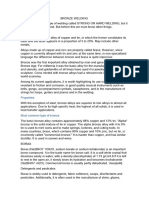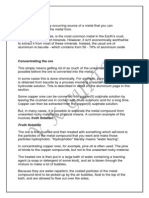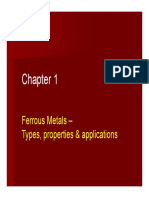Bronze and Its Melting Process - 1
Bronze and Its Melting Process - 1
Uploaded by
dom2Copyright:
Available Formats
Bronze and Its Melting Process - 1
Bronze and Its Melting Process - 1
Uploaded by
dom2Original Description:
Copyright
Available Formats
Share this document
Did you find this document useful?
Is this content inappropriate?
Copyright:
Available Formats
Bronze and Its Melting Process - 1
Bronze and Its Melting Process - 1
Uploaded by
dom2Copyright:
Available Formats
1
STUDY NOTES ON GUNMETAL AND ITS MELTING PROCESS
Bronze is basically an alloy of Copper and Tin. Tin changes the colour of copper, a small %
turns copper yellow, when at 30% tin it becomes almost white. The % of tin also effects the
workable properties of bronze.
@ 5% Tin it can be cold worked, i.e. Bronze coinage.
@ 12% Tin it ceases to be malleable.
@ 20% Tin it is very brittle and called bell metal.
@ 18% Tin it is at its strongest.
@ 10% Tin it is called Gunmetal, as was used in ordnance, it casts well with a fine
grain structure.
Most modern gunmetal (BS. 1400 LG alloys) contains some Zinc and Lead which improve
the castability and act chemically in the alloy.
Metal
Melting Point deg.C
Boiling Point deg.C
Copper
Tin
Zinc
Lead
1083
232
419
327
2595
2270
960
1740
Molten copper absorbs oxygen and hydrogen from the atmosphere. Liquid copper oxidizes
freely and this oxide dissolves forming a solution with the liquid un-oxidized copper. When
the copper freezes the copper oxide comes out of solution and into suspension throughout
the casting, making it weak. Dissolved hydrogen in the melt is ejected from solution upon
freezing and can combine with the oxygen in copper oxide producing, copper and water
(steam), causing defects within the casting.
Molten tin oxidizes but doesnt go into solution with the copper, the tin oxide rising to the top
as scum.
When zinc is added into the alloy the zinc tends to de-oxidize the copper, by oxidizing itself
in preference to copper and converting copper oxide back into copper. The zinc oxide is
insoluble in copper and floats to the top. Zinc also evaporates at these temperatures so
volatilization losses can occur. Manganese, Silicon and Phosphorus also act as deoxidizers in copper much like zinc does (phosphorus being the strongest deoxidizer.) These
elements are also constituents in other types of bronze and are named accordingly.
Copper and tin mix perfectly when molten together. But on solidification Tin can rise in the
casting, so more tin can be at the top than the bottom. When lead is present in the alloy
and freezing takes place too slowly lead will liquate out, or flake out. Slow freezing also
produces a coarse grain or crystal structure in the alloy
So in the melting / pouring process oxidization needs to be minimized and impurities
removed. Covering the melt in charcoal grains or dust (dust may get into the cast during
pouring) to some extent stops oxidization which burns on top of the melt, using oxygen
before it reaches the metal. A flux is used to slag of impurities, some fluxes are:
Salamoniac
= Ammonium Chloride
Pearl ash
= Potassium Carbonate
Cream of tartar
= Potassium Hydrogen Tartrate
Common salt
= Sodium Chloride
Borax
= Sodium Tetraborate
Powdered glass
= # (Bad for crucibles)
Proprietary cover fluxes, fluxes, coveralls and de-oxidizers are probably most convenient.
Crucibles are made from graphite, clay graphite, silicon carbide. Clay graphite crucibles
are fragile when cold but are quite strong when hot and a bit plastic with it. Silicon carbide
has better resistance to thermal shock and doesnt absorb moisture. Good fitting crucible
tools are needed to prevent damage. Crucibles should be warmed up evenly the opening
downwards (to red hot) before going into a hot furnace. The charge can also be heated.
Charcoal or cardboard should be placed between the crucible and its stand to stop them
sticking together and also between the stand and furnace base. Completely emptying
crucibles between melts will eliminate the chance of solidified metal creating cracks through
expansion. Dross and oxides left in the crucible should be scraped of gently while still hot.
Metal tools: dross rake / scraper / ladle, plunger, lift tongs, pole, pouring shank, pouring
ladle, ingot moulds, etc. are coated / dipped / dressed with a refractory and warmed / prewarmed as necessary before use to dry them. This coating and warming stops the melt
freezing to the tools and helps prevent thermal shock to crucibles.
The metal should be melted in short a time as possible and not held in its molten state any
longer than necessary. Care must be taken not to materially exceed the melting
temperature of the alloy, yet the best pouring temperature will probably need some
superheat. Agitation of the melt should be kept to a minimum and the slag that forms left
intact as much as possible, to minimize atmospheric contamination before the crucible is
removed from the furnace.
A working method could be, a cover flux is added towards the beginning of the melt, as the
solid metal turns liquid more solid can be added as required, dont jam solid metal into
crucibles the expansion can crack them. With the slag left in tact as much as possible.
Remove the crucible from the furnace and place on a refractory block that is inside the ring
of the pouring shank (on the foundry floor), the melt skimmed and a warmed deoxidizer
plunged through the melt. As the casting is being poured any dross is held back.
Gunmetal looses its strength rapidly from 200 deg. C onwards, at about 500 deg. C larger
pieces could be broken up before melting.
If additional alloying is to take place (starting with the highest melting point metal), the
addition should be heated, then carefully added to the covered & fluxed melt in the crucible,
a bit at a time so preventing freezing, and cautiously but continuously stirred/poled in to mix
the metals. Stirring sticks/poles should be of green wood e.g. oak or beech, copper or
quartz!. Iron will contaminate the bronze.
Alloys such as phosphor bronze and gunmetal solidify or freeze over a fairly wide range of
temperature, 100-180 deg.C and are long freezing alloys as opposed to short, so they flow
and pour more easily. During solidification a pasty state is reached where the metal doesnt
flow freely, so feeding and shrinkage problems can occur. This can be avoided with good
design and casting technique. Good practice is to avoid variations in wall thickness and
use the minimum wall thickness practicable. Sections of up to 9mm thick can be cast
without porosity, with good practice. Sections of 10 to 19mm, porosity may exist, above
19mm things become progressively more difficult. Castings in lead free gunmetal and
phosphor bronze are not easy without porosity.
Oxy-acetylene welding and brazing is satisfactory for tin bronzes and gunmetal, but not for
lead bronzes. Lead being the problem. Generally joints have less resistance to corrosion.
The effects of the atmosphere on the natural patina of a bronze depend on its environment.
The normal bronze patina in a clean rural setting. A darker tarnish in polluted urban areas
due to sulphur compounds, (high sulphur dioxide levels e.g. By a chimney, being a rather
corrosive sighting. In a marine setting a green colour develops.
Industrially gunmetal is sometimes used because of its corrosion resistance to chemical
solutions like some non-oxidizing acids and alkaline solutions. Substances such as sodium
hydroxide, sulfuric acid, acetic, formic, oxalic, citric, tannic acids, though the performance
varies depending on concentrations.
Gunmetal is attacked by Nitric acid (rapidly) and hydrochloric acid. Hydrogen sulphide,
Ammoniacle compounds and ammonia gases are avoided.
There are many copper casting alloys listed under various standards. They can be broken
down into various group names: High conductivity coppers (HCC)
Brasses (SCB, DCB, DZR,)
High tensile brasses (HTB)
Phosphor bronzes (PB)
Tin bronzes (CT)
Gunmetals (Leaded)(LG)
Lead bronzes (LB)
Aluminium bronzes (AB)
Cupro-nickles (CN)
Manganese bronzes (HTB)
Silicon brass (HTB)
Gunmetals (no longer listed)(G)
Silicon bronze
In the gunmetal / lead bronze groups the lead content varies from 3% for LG4 to 20% for
LB5.
The above notes should not be used too form a specification or technique.
You might also like
- LECO Cs 230 ManualDocument48 pagesLECO Cs 230 ManualDmitriy ChifinNo ratings yet
- Soldering & WeldingDocument82 pagesSoldering & WeldingRachita Arora100% (1)
- Extraction of IronDocument4 pagesExtraction of IronNadita100% (1)
- Metals 2023 2024Document36 pagesMetals 2023 2024Joshua TupasNo ratings yet
- Tin and Tin AlloysDocument22 pagesTin and Tin AlloysstainedClassNo ratings yet
- Fourth 3 2 Erosion CorrosionDocument80 pagesFourth 3 2 Erosion CorrosionNasser AbdNo ratings yet
- Bronze WeldingDocument6 pagesBronze WeldingScribdTranslationsNo ratings yet
- Manufacture of Substnces in Industry2Document18 pagesManufacture of Substnces in Industry2api-3735786No ratings yet
- Conmatest 7Document46 pagesConmatest 7Ian BondocNo ratings yet
- Ferrous and Non-Ferrous MetalDocument8 pagesFerrous and Non-Ferrous MetalJayChristian QuimsonNo ratings yet
- Chem PRDocument16 pagesChem PRYashraj NarwariyaNo ratings yet
- Modern Steel - Lecture 1Document54 pagesModern Steel - Lecture 1Jojo Hany100% (1)
- Arwachin Bharti Bhawan School Project On Chemistry: Study of Constituents of Alloys Submitted By:-Prankur RajDocument9 pagesArwachin Bharti Bhawan School Project On Chemistry: Study of Constituents of Alloys Submitted By:-Prankur RajRajKumarNo ratings yet
- Lesson One. Iron and SteelDocument6 pagesLesson One. Iron and SteelcharguibachaghaNo ratings yet
- CorrosionDocument4 pagesCorrosionrishikeshsunbeamianNo ratings yet
- Metals Updated - 240327 - 155648Document19 pagesMetals Updated - 240327 - 155648jhkxt22n9sNo ratings yet
- ReportDocument3 pagesReportShamRock CasasNo ratings yet
- Final File-Rahul ChandraDocument18 pagesFinal File-Rahul Chandra8bitdeku69No ratings yet
- Lime in Iron OreDocument14 pagesLime in Iron Oreranjeet_nismNo ratings yet
- Metals and Non-MetalsDocument4 pagesMetals and Non-Metalsrinnann.22No ratings yet
- Casting Alloys: V.NivedhaDocument84 pagesCasting Alloys: V.NivedhaApurva Deshmukh100% (1)
- Dental Casting and Soldering AlloysDocument40 pagesDental Casting and Soldering AlloysMella Bella WilsonNo ratings yet
- 15 - Extraction of MetalsDocument9 pages15 - Extraction of MetalsIzzah AnatiNo ratings yet
- Tin T1Document2 pagesTin T1ThunderkickNo ratings yet
- Unit - Iii: Ferrous and Non Ferrous MetalsDocument101 pagesUnit - Iii: Ferrous and Non Ferrous Metalssenthilkumar tsNo ratings yet
- 2 Non Ferrous Metals and AlloysDocument10 pages2 Non Ferrous Metals and AlloysAkperheNo ratings yet
- Metallurgy NotesDocument13 pagesMetallurgy NotesAbhinav JainNo ratings yet
- 4 Kramer Good Foundry PracticesDocument25 pages4 Kramer Good Foundry PracticeshezihilikNo ratings yet
- Extraction of Iron From Iron OreDocument8 pagesExtraction of Iron From Iron OreahmadnazribinabuNo ratings yet
- Fe 2O3 Fe 3O4: Extracting Iron From Iron Ore Using A Blast FurnaceDocument5 pagesFe 2O3 Fe 3O4: Extracting Iron From Iron Ore Using A Blast FurnaceTej SHahNo ratings yet
- Steel Making2Document147 pagesSteel Making2satish_trivediNo ratings yet
- 10 Non-Ferrous and Other TopicsDocument14 pages10 Non-Ferrous and Other TopicsShuvo Chandra DasNo ratings yet
- Ferrous Metals - Properties and ApplicationDocument20 pagesFerrous Metals - Properties and ApplicationMohan RaiNo ratings yet
- Pengekstrakan BesiDocument5 pagesPengekstrakan BesiNajwa Ghazali100% (1)
- Metals OlevleDocument9 pagesMetals OlevleaayannisarNo ratings yet
- Aluminium Die CastingDocument8 pagesAluminium Die CastingsivamettNo ratings yet
- Chemistry Project 2016Document20 pagesChemistry Project 2016Divya KumawatNo ratings yet
- Steel and Other Alloying ElementDocument62 pagesSteel and Other Alloying ElementJoby Jobzz SebellinoNo ratings yet
- Study of Constituents of Alloys: Swarnprastha Public School Chemistry ProjectDocument13 pagesStudy of Constituents of Alloys: Swarnprastha Public School Chemistry Projectvineetsinghal83% (12)
- Study of Constituents of AlloysDocument14 pagesStudy of Constituents of AlloysManish NaharNo ratings yet
- Building Materials - Ferrous and Non-FerrousDocument24 pagesBuilding Materials - Ferrous and Non-FerrousDevansh MehtaNo ratings yet
- Lecture 8 - Selective LeachingDocument16 pagesLecture 8 - Selective Leachingprakush01975225403No ratings yet
- Bgtech 1 Research Paper Ferrous and Non Ferrous Metals: Far Eastern University Institute of Architecture and Fine ArtsDocument23 pagesBgtech 1 Research Paper Ferrous and Non Ferrous Metals: Far Eastern University Institute of Architecture and Fine ArtsRousseau Pierre LouisNo ratings yet
- INTRODUCTION TO STEEL - Part 1Document85 pagesINTRODUCTION TO STEEL - Part 1ragulNo ratings yet
- Base Metals and Base-Metal Family Groups: Metallurgical ReactionsDocument114 pagesBase Metals and Base-Metal Family Groups: Metallurgical ReactionsYasa CossioNo ratings yet
- SolderingAnnealing 1544008648860Document12 pagesSolderingAnnealing 1544008648860Cristal MuranoNo ratings yet
- Ch13 Materials ApplicationsDocument69 pagesCh13 Materials ApplicationsRhanganath ArivudainambiNo ratings yet
- BrassesDocument7 pagesBrassesClaudia MmsNo ratings yet
- Soldering 101 - Oxidation, Flux and Fire Scale PreventionDocument12 pagesSoldering 101 - Oxidation, Flux and Fire Scale PreventionEdu2k7No ratings yet
- Metals and Non-MetalsDocument51 pagesMetals and Non-MetalsSubir BiswasNo ratings yet
- Work Hardening and Annealing CuDocument1 pageWork Hardening and Annealing CuArdi VillanuevaNo ratings yet
- Cast Iron - WikipediaDocument48 pagesCast Iron - WikipediaLAliNo ratings yet
- Tcbe 1202-3 MetalsDocument15 pagesTcbe 1202-3 MetalsshafikNo ratings yet
- FP 247 03 Sand Cast BronzesDocument4 pagesFP 247 03 Sand Cast BronzesnfcastingsNo ratings yet
- Assignment CompioDocument4 pagesAssignment CompioDominic CompioNo ratings yet
- Metallurgical Class OverviewDocument59 pagesMetallurgical Class OverviewsyedfarazshafeeqNo ratings yet
- Soldering Vs BrazingDocument11 pagesSoldering Vs BrazingShu CedricNo ratings yet
- The Working of Steel: Annealing, Heat Treating and Hardening of Carbon and Alloy SteelFrom EverandThe Working of Steel: Annealing, Heat Treating and Hardening of Carbon and Alloy SteelNo ratings yet
- Astm D4Document3 pagesAstm D4Vijayan Munuswamy100% (1)
- PoDFA Flyer and Spec SheetDocument6 pagesPoDFA Flyer and Spec SheetAmmarNo ratings yet
- Complete Metal Casting Instruction Ebook Package For The Hobby Foundry WorkerDocument8 pagesComplete Metal Casting Instruction Ebook Package For The Hobby Foundry WorkerMarcelo IpolitoNo ratings yet
- Standard Test Method For Acid InsolubleDocument2 pagesStandard Test Method For Acid Insolubledhy182No ratings yet
- Viking Heritage Magazine 1 05 PDFDocument40 pagesViking Heritage Magazine 1 05 PDFBeksacNo ratings yet
- Harris QCA 8e ExperimentsDocument125 pagesHarris QCA 8e ExperimentsHector RojasNo ratings yet
- Indian Standard: Specification For Barium Sulphate Pigments For PaintsDocument14 pagesIndian Standard: Specification For Barium Sulphate Pigments For PaintsPraveen Reddy GundalaNo ratings yet
- Chemistry Formal LabDocument5 pagesChemistry Formal LabRyan HolinsheadNo ratings yet
- Lab Equipments ReviewerDocument8 pagesLab Equipments ReviewerCherish Faith TubigNo ratings yet
- Unclassified Ad Number Limitation Changes TODocument36 pagesUnclassified Ad Number Limitation Changes TORuben's OscarNo ratings yet
- MSE 116 Problem Set 1Document2 pagesMSE 116 Problem Set 1Isaiah James Balista Perez100% (1)
- Casting Procedure and Casting DefectsDocument85 pagesCasting Procedure and Casting DefectsChaithraNo ratings yet
- Experiment of Determination of Ash ContentDocument9 pagesExperiment of Determination of Ash ContentMimie Rosidi100% (1)
- 2.3 Sulfated Ash: The International Pharmacopoeia - Ninth Edition, 2019Document1 page2.3 Sulfated Ash: The International Pharmacopoeia - Ninth Edition, 2019JAHIDUL ISLAMNo ratings yet
- ApparatusDocument10 pagesApparatusJohann Darnley100% (1)
- Angie C. Dominguez, Laura L. Trujillo .: Gravimetric Moisture and Ash Determination, of Achira Sponge CakeDocument8 pagesAngie C. Dominguez, Laura L. Trujillo .: Gravimetric Moisture and Ash Determination, of Achira Sponge CakeAngie Carolina DomínguezNo ratings yet
- Law of Definite Proportions LabDocument3 pagesLaw of Definite Proportions LabJonathan MendarosNo ratings yet
- Is 14399 1-2 1996Document27 pagesIs 14399 1-2 1996amjadmalik75No ratings yet
- THermit Rialtech - InstructionDocument17 pagesTHermit Rialtech - Instructionbest_wisitNo ratings yet
- Standardization of The Carbon-Phenolic Materials and ProcessesDocument281 pagesStandardization of The Carbon-Phenolic Materials and Processesuebricc100% (1)
- Laboratory Solutions: Sample Preparation For The Most Stringent Analytical RequirementsDocument37 pagesLaboratory Solutions: Sample Preparation For The Most Stringent Analytical Requirementsomar rahmounNo ratings yet
- Ash Determination LectureDocument28 pagesAsh Determination LectureNasir AhmedNo ratings yet
- Modern Melting and Holding Furnaces For Light Metals: F. OstlerDocument8 pagesModern Melting and Holding Furnaces For Light Metals: F. OstlerRaj Kumar GiriNo ratings yet
- Equipment in Chemistry LaboratoryDocument5 pagesEquipment in Chemistry LaboratoryIstiva AmeiliaNo ratings yet
- Magnesium Oxide Lab ReportDocument5 pagesMagnesium Oxide Lab ReportNarendran Sairam65% (17)
- UrlDocument42 pagesUrlmaraki998100% (1)
- Woven Orchard Protection Crop Cover SpecificationDocument18 pagesWoven Orchard Protection Crop Cover SpecificationVinay Tripathi100% (1)
- Standard Test Methods For Water Solubility of WoodDocument2 pagesStandard Test Methods For Water Solubility of WoodSyed Muneeb HaiderNo ratings yet
- Phoenix Black-Microwave Muffle FurnaceDocument12 pagesPhoenix Black-Microwave Muffle FurnaceMARCOS ALEJANDRO CHAMORRO TRUJILLONo ratings yet

























































































